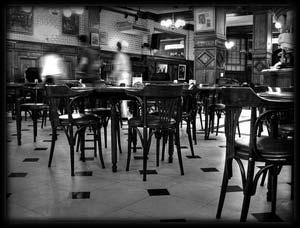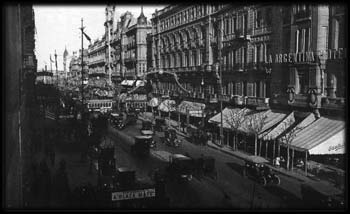By
The nose pressed on the glass (Some barrooms in the Argentine movies - Second part)

ESUBIO
A luxurious ice-cream parlor. It was on Corrientes Avenue between Libertad and Cerrito, quite close to the Broadway movie theater. It still is there but it has become a hybrid fast-food local even though it still keeps some of its frozen desserts.
 It was born in the early 30s and with the arrogance of that time: an Italian setting made of expensive materials, beveled mirrors, tonet chairs and a stained-glass window that reproduced the famous Neapolitan volcano. It was renowned for its sundaes, melba dishes, banana splits but also because Carlos Gardel used to go there almost every afternoon.
It was born in the early 30s and with the arrogance of that time: an Italian setting made of expensive materials, beveled mirrors, tonet chairs and a stained-glass window that reproduced the famous Neapolitan volcano. It was renowned for its sundaes, melba dishes, banana splits but also because Carlos Gardel used to go there almost every afternoon.
In 1933 a municipal inspection ordered its closure because a client was intoxicated but it finally was not proved. The day it reopened Gardel was the first patron to enter the Vesubio. Its most expensive ice-cream was named Friar Inca (we never knew why) and it consisted of three balls of chocolate, Russian cream and American cream, all garnished with chocolate syrup and dulce de leche (milk-based sauce). It was joyously tasted by the actress Leonor Rinaldi.
ROYAL KELLER
It was on Corrientes near Esmeralda. It was a local for white collar people, that is to say, conservatives. Roomy and very nicely designed, this café and restaurant attracted a different attendance because besides the political reunions there were also a literary and a theater coterie. The latter had its sanctuary at the basement where once a week the writer Alberto Hidalgo presented its Oral Magazine, seemingly, to much acclaim.
Despite it was not tinged with ideology, the participating figures belonged to the Florida group: Oliverio Girondo (very few know that besides being a poet he was very rich), Jorge Luis Borges, Macedonio Fernández and Ricardo Güiraldes. A curious information that I got —like many more— from the researcher and painter Ana María Moncalvo who also recalls that in his drama Los muertos Florencio Sánchez includes a scene that remembers this basement.
LA COSECHERA
On Avenida de Mayo 625. It had two more locals on the same avenue, one on 800 and the other on 1200. In general not many actors used to go there but it was frequented by writers and critics (although not at the same time). Due to its features —high quality coffee and good dairy products— it was the ideal place for the completo, coffee with milk, bread and butter, that replaced so many lunches and dinners for the stomachs of artists, writers and journalists. Edmundo Guibourg, Agustín Remón —a Spaniard with bad temper—, Andrés Romeo, Julio Viale Paz, Carlos Gallo, Martín Lemos were some of the ones that commented the theatrical premieres for the papers of the Capital city.
 The practice of a sharp and witty humor, and even openly malevolent, was a daily gymnastics at La Cosechera. From there came many darts thrown from the columns devoted to theater gossiping. A queer joke by Remón: «I want to go to the Basque country before I die but the tickets for the steamships of the British Royal Mail Lines are very expensive…» «Why don’t you go on an Italian boat with a cheaper second class?» «’cause the Royal Mail Line is the company that wrecks best…»
The practice of a sharp and witty humor, and even openly malevolent, was a daily gymnastics at La Cosechera. From there came many darts thrown from the columns devoted to theater gossiping. A queer joke by Remón: «I want to go to the Basque country before I die but the tickets for the steamships of the British Royal Mail Lines are very expensive…» «Why don’t you go on an Italian boat with a cheaper second class?» «’cause the Royal Mail Line is the company that wrecks best…»
LA TERRAZA
Later Premier and it still has that name. It has now turned into a pizzeria and cafeteria but it is always located on the corner of Corrientes and Paraná. It was a food local highly frequented by theater people in the 20s and 30s. In summer the upper outdoor floor was used. Hence its name.
Nearly all those connected with theater used to go there but there were tables with tough and fearsome guys. One was the one of Pablo Suero, a brilliant theatrical journalist, who usually got drunk and then he underwent the classic process of Doctor Jekyll and Mr. Hyde. The bad thing is that he wanted to fight with anyone and as he was quite fat and with short arms he usually ended up heavily beaten. In general, people tried to elude him and the owner of La Terraza, Raffeto, had not allowed his admittance.
Ordinary dishes were served but of a good quality and well made. The actor Osvaldo Miranda was a regular patron. He told us that on a very cold night the tango singer Carlitos Roldán, freezing, arrived dressed with a palm beach suit, the typical summer outfit, but wearing gloves. Maliciously, somebody asked him: «Carlitos, is it cold?» «Are you serious? Poor of the one that does not wear gloves tonight!»
EL ATENEO
Facing and diagonally to the Seminario, a theatrical venue that shared its patrons with the others of that sort, was El Ateneo on Carlos Pellegrini and Perón. It was one of the few that had won movie people, in general rare as for the typical cafe on Corrientes, as they were rather focused on the area of Lavalle and Ayacucho where always movie distributors had been based.
 But El Ateneo was an exception and there no less than Artistas Argentinos Asociados was born, the Argentine independent movie enterprise that has its own mythology. At those tables were reunited Enrique Muiño, Elías Alippi, Francisco Petrone, Ángel Magaña, Lucas Demare and Enrique Faustín, its creators. There they met the owner of the San Miguel studios, the impresario Miguel Machinandiarena, who would be of vital importance for their beginnings.
But El Ateneo was an exception and there no less than Artistas Argentinos Asociados was born, the Argentine independent movie enterprise that has its own mythology. At those tables were reunited Enrique Muiño, Elías Alippi, Francisco Petrone, Ángel Magaña, Lucas Demare and Enrique Faustín, its creators. There they met the owner of the San Miguel studios, the impresario Miguel Machinandiarena, who would be of vital importance for their beginnings.
The bohemians of El Ateneo achieved shooting La guerra gaucha, Todo un hombre, Su mejor alumno, El muerto falta a la cita, Pampa bárbara and Donde mueren las palabras, among others. With less luck other actors and directors planned similar heroic deeds at the same salon, maybe driven by the magic thought that AAA was a label generated by the elf of El Ateneo and not by the inspiration, the sweat and the financial risk of those who forged it. And it can be understood. Why cafes were born for if not to built castles in the air? They were built by thousands on the places that this chapter tried to bring back to life.
From the book: Los escenarios del adiós, published by the Universidad Nacional de Mar del Plata.